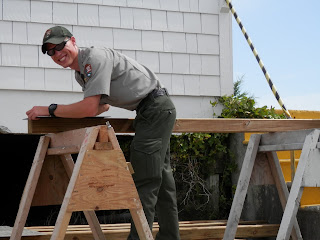Hello again from North Carolina!
The past two weeks have been filled with new experiences and opportunities at Cape Hatteras National Seashore. During the past two weeks, my supervisor (Ranger Krebs) and I have been assigned to work the early shift at the park. I really enjoyed working the early shift schedule, and getting the opportunity to patrol the park at irregular hours. A unique component of law enforcement work is that enforcement is a 24- hour job. In turn, law enforcement Rangers must work schedules that vary from the traditional 9 to 5 work day. Although your basic duties remain the same, the focus of each shift can largely depend on the time of day and what schedule you are working.
Since we were assigned to the early shift, one of our primary duties was to patrol the beach for "night-driving" violations. Although the beach is open to pedestrian traffic on a 24- hour basis, vehicle access is restricted during overnight hours.Under the Off-Road Vehicle (ORV) management plan, the use of ORV's between the hours of 9:00 p.m. and 7:00 a.m. is prohibited. This regulation serves to protect nesting sea turtles from vehicle traffic and prevents the sea turtles from becoming distracted by the light emitted from passing vehicles. The 7:00 a.m. opening time also allows the parks Natural Resources Division time to inspect the beaches and mark any new turtle nests.
 |
| Chalking tires to check for 24-Hour parking violations. |
In addition to patrolling the beaches for night-driving violations, my supervisor and I were responsible for checking in with other divisions and obtaining status updates on their activities. It is important that all of the parks divisions work together and become familiar with each others activities. As an agency, we are all responsible for serving the visiting public. The more familiar we are with the other divisions, the better we are able to answer questions and provide quality services to the visitors. Maintaining a good relationship with the other divisions also helps establish patrol priorities and creates and environment where vital information is shared among the staff members.
One example of inter-division coordination occurred during one of our early shifts last week. As we were patrolling the beach, Ranger Krebs received a call from a Natural Resources Bio-Tech who was conducting a routine turtle patrol. During his patrol, the Bio-Tech discovered that one of the turtle nests had been vandalized during the previous night. Ranger Krebs and I were on another call at the time, but we obtained the location of the disturbed nest and gathered information from the Bio-Tech. Fortunately, no turtle eggs were harmed by the vandals, and the Bio-Tech was able to fix the damaged enclosure after taking pictures for our investigation.
After clearing our previous call, Ranger Krebs and I responded to the site of the damaged turtle nest and conducted an investigation. Since the enclosure was positioned on a soft area of the beach, we were able to identify footprints and other marks that were left by the violators. We traced these marks to a nearby housing development, where they were covered by other foot-traffic. Although we could not follow the footprints to a specific location, Ranger Krebs and I searched the area for a park sign that was taken from the turtle nest and talked to residents of the area. We informed the residents about the damaged nest, and asked them to contact us if they had any information about the crime.
 |
| Turtle tracks leading to and from the nest/Atlantic Ocean. |
 |
| Turtle Egg, placed next to the nest where it was found. |
Thus far, I have been describing a few of the patrol duties that we have been responsible for over the past few weeks. As important as these duties are, National Park Service Rangers are also tasked with several collateral duties that must be completed. This week, one of our major collateral assignments was to decommission two of the parks law enforcement vehicles. Each year, the park has to replace vehicles that have reached the end of their service life. In an ocean environment, vehicles quickly rust and become damaged by the elements. Before decommissioning a vehicle, all of the law enforcement equipment must be removed and saved for the new patrol vehicles. Ranger Krebs and I were charged with emptying the vehicles and transporting them to park headquarters. As mentioned in my previous post, the park headquarters are located in Manteo, NC, about an hours drive from our location on Hatteras Island.
 |
| Driving the Fire Engine back to Hatteras Island. |
 |
| The Fire Engine, returned to it's quarters on HI |
 |
| Adding new signs to the sign cache |
 |
| Building new signs! |
 |
| More building! |
 |
| The finished product! |
These are only a few examples of my experiences over the past two weeks! I hope that these stories highlight the wide-ranging duties and responsibilities of U.S. Park Ranger's. Next week, I will be working with the Interpretation Division to administer visitor programs and provide assistance at the Cape Hatteras Light Station.
Thank you for your continued interest in ProRanger Philadelphia!
Jay Copper


Can't wait to see pictures of those turtles!
ReplyDeleteHi there! Nice stuff, do keep me posted when you post again something like this!
ReplyDeleteNational University of Singapore Clementi